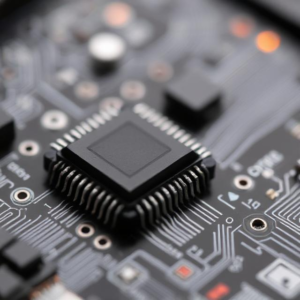What is the Internet of Things (IoT)?
The Internet of Things (IoT) refers to a network of everyday objects—like devices, vehicles, home appliances, and even clothing—that are connected to the internet and can send and receive data. These objects, often called smart devices, can collect information from their surroundings, share it, and sometimes even take actions based on that information without human intervention.
For example, a smart thermostat in your home can adjust the temperature automatically based on your schedule or your preferences, or a smart fridge can alert you when you’re running low on milk.

Key Features of IoT:
- Connectivity: IoT devices are connected to the internet, allowing them to send and receive data.
- Data Collection: IoT devices gather data from their environment (e.g., temperature, location, motion).
- Automation: Based on the data, IoT devices can make decisions or perform actions automatically.
- Remote Control: Many IoT devices can be controlled from anywhere through your smartphone or computer.
Examples of IoT Devices:
- Smart Home Devices:
- Smart Thermostats (e.g., Nest): Automatically adjust your home’s temperature based on your usage patterns or your preferences.
- Smart Lights (e.g., Philips Hue): Control your home’s lighting from your phone or even set up schedules.
- Smart Security Cameras (e.g., Ring): Let you monitor and record video footage from anywhere, and alert you to movement or sound.
- Wearable Devices:
- Smartwatches (e.g., Apple Watch, Fitbit): Track your physical activity, health stats (like heart rate), and can even notify you of messages or calls.
- Smart Glasses: Devices that overlay information on your vision (e.g., Google Glass).
- Smart Vehicles:
- Connected Cars (e.g., Tesla): Cars that communicate with each other and infrastructure to improve safety, provide real-time navigation, or even park themselves.
- Fleet Management: Trucks with IoT sensors to track location, monitor driver behavior, and ensure cargo safety.
- Smart Appliances:
- Smart Refrigerators (e.g., Samsung Family Hub): Can suggest recipes, make shopping lists, and track expiration dates.
- Smart Washing Machines: Can be controlled remotely via your phone to start washing when you’re away from home.
-
Healthcare Devices:
- Smart Blood Pressure Monitors: Devices that send your health data directly to a doctor or a healthcare system.
- Smart Pills: Pills that send data about your body to healthcare providers (e.g., tracking medication intake or vitals).
Applications of IoT:
- Smart Homes:
- IoT is widely used to automate and control home systems. You can control lighting, heating, and security remotely using a smartphone or voice commands (like Alexa or Google Assistant).
- Example: You can turn off the lights and adjust the thermostat when you’re about to leave the house, saving energy.
- Healthcare:
- IoT devices like wearables (smartwatches, fitness trackers) monitor health data in real-time. Healthcare systems also use IoT to track patient vitals, help with remote consultations, and improve overall treatment.
- Example: A smart insulin pen can help diabetic patients track their insulin dosage and send the data directly to their doctor.
- Smart Cities:
- IoT helps in creating smart cities where various systems (traffic, energy, waste management) are connected and optimized for efficiency. Smart traffic lights, for example, can adjust based on real-time traffic flow, reducing congestion.
- Example: Smart waste bins can notify waste collection services when they are full, reducing the frequency of pickups and saving resources.
- Agriculture:
- IoT is transforming farming through smart sensors that monitor soil moisture, weather, crop health, and other conditions. This enables precision farming, which increases crop yields and minimizes waste.
- Example: A smart irrigation system uses moisture sensors to water plants only when necessary, conserving water.
- Industrial IoT (IIoT):
- In factories and warehouses, IoT devices can monitor machinery, track inventory, and improve productivity. For instance, smart sensors can detect when a machine is about to break down, allowing for timely maintenance.
- Example: A smart factory can use IoT to track production lines in real-time and adjust operations based on performance data.
- Retail:
- Retailers use IoT to track inventory, improve customer experience, and optimize supply chains. Smart shelves can alert store staff when products are running low, and RFID tags help track items in real-time.
- Example: Amazon Go stores use IoT sensors to automatically detect what items you take, allowing for a checkout-free shopping experience.
- Transportation and Logistics:
- IoT helps track the movement of goods and vehicles. It enables real-time tracking of shipments, fleet management, and efficient route planning.
- Example: A smart delivery truck can monitor its cargo’s condition, location, and even fuel usage, sending data back to the company for optimized delivery schedules.
Benefits of IoT:
- Convenience: Automates tasks and allows remote control and monitoring of devices.
- Efficiency: Optimizes operations and saves time, energy, and resources (e.g., in homes, factories, transportation).
- Improved Decision Making: With real-time data, people and organizations can make better, more informed decisions.
- Enhanced Safety and Security: Devices like smart cameras or health monitors help detect issues early and alert users.
Challenges of IoT:
- Security: More connected devices can lead to more opportunities for hacking or data breaches. Ensuring data privacy and secure connections is critical.
- Interoperability: Not all IoT devices work well together, and creating standards to ensure they can communicate is a challenge.
- Data Overload: With so many devices collecting data, it can become overwhelming to analyze and make use of it all effectively.
Summary:
The Internet of Things (IoT) connects everyday objects to the internet, allowing them to collect and exchange data. It has applications in various fields like smart homes, healthcare, agriculture, and industrial settings. IoT improves efficiency, convenience, and decision-making but also presents challenges like security concerns and data management.
As IoT continues to grow, we will see even more innovative ways that devices and systems will work together to create smarter and more connected environments!











